Solar eclipse of December 27, 2065
A partial solar eclipse will occur at the Moon's ascending node of orbit on Sunday, December 27, 2065, with a magnitude of 0.8769. A solar eclipse occurs when the Moon passes between Earth and the Sun, thereby totally or partly obscuring the image of the Sun for a viewer on Earth. A partial solar eclipse occurs in the polar regions of the Earth when the center of the Moon's shadow misses the Earth.
This will be the last of four partial solar eclipses in 2065, with the others occurring on February 5, July 3, and August 2.
Related eclipses
Eclipses in 2065
- A total lunar eclipse on January 22.
- A partial solar eclipse on February 5.
- A partial solar eclipse on July 3.
- A total lunar eclipse on July 17.
- A partial solar eclipse on August 2.
- A partial solar eclipse on December 27.
Metonic
- Preceded by: Solar eclipse of March 11, 2062
- Followed by: Solar eclipse of October 15, 2069
Tzolkinex
- Preceded by: Solar eclipse of November 16, 2058
- Followed by: Solar eclipse of February 7, 2073
Half-Saros
- Preceded by: Lunar eclipse of December 22, 2056
- Followed by: Lunar eclipse of January 2, 2075
Tritos
- Preceded by: Solar eclipse of January 27, 2055
- Followed by: Solar eclipse of November 26, 2076
Solar Saros 123
- Preceded by: Solar eclipse of December 16, 2047
- Followed by: Solar eclipse of January 7, 2084
Inex
- Preceded by: Solar eclipse of January 16, 2037
- Followed by: Solar eclipse of December 7, 2094
Triad
- Preceded by: Solar eclipse of February 26, 1979
- Followed by: Solar eclipse of October 28, 2152
Solar eclipses of 2065–2069
This eclipse is a member of a semester series. An eclipse in a semester series of solar eclipses repeats approximately every 177 days and 4 hours (a semester) at alternating nodes of the Moon's orbit.[1]
The partial solar eclipses on February 5, 2065 and August 2, 2065 occur in the previous lunar year eclipse set, and the partial solar eclipses on April 21, 2069 and October 15, 2069 occur in the next lunar year eclipse set.
| Solar eclipse series sets from 2065 to 2069 | ||||||
|---|---|---|---|---|---|---|
| Descending node | Ascending node | |||||
| Saros | Map | Gamma | Saros | Map | Gamma | |
| 118 | July 3, 2065 Partial | 1.4619 | 123 | December 27, 2065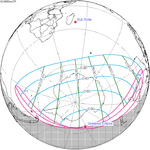 Partial | −1.0688 | |
| 128 | June 22, 2066 Annular | 0.733 | 133 | December 17, 2066 Total | −0.4043 | |
| 138 | June 11, 2067 Annular | −0.0387 | 143 | December 6, 2067 Hybrid | 0.2845 | |
| 148 | May 31, 2068 Total | −0.797 | 153 | November 24, 2068 Partial | 1.0299 | |
| 158 | May 20, 2069 Partial | −1.4852 | ||||
Saros 123
This eclipse is a part of Saros series 123, repeating every 18 years, 11 days, and containing 70 events. The series started with a partial solar eclipse on April 29, 1074. It contains annular eclipses from July 2, 1182 through April 19, 1651; hybrid eclipses from April 30, 1669 through May 22, 1705; and total eclipses from June 3, 1723 through October 23, 1957. The series ends at member 70 as a partial eclipse on May 31, 2318. Its eclipses are tabulated in three columns; every third eclipse in the same column is one exeligmos apart, so they all cast shadows over approximately the same parts of the Earth.
The longest duration of annularity was produced by member 19 at 8 minutes, 7 seconds on November 9, 1398, and the longest duration of totality was produced by member 42 at 3 minutes, 27 seconds on July 27, 1813. All eclipses in this series occur at the Moon’s ascending node of orbit.[2]
| Series members 42–63 occur between 1801 and 2200: | ||
|---|---|---|
| 42 | 43 | 44 |
 July 27, 1813 | 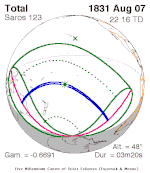 August 7, 1831 |  August 18, 1849 |
| 45 | 46 | 47 |
 August 29, 1867 |  September 8, 1885 |  September 21, 1903 |
| 48 | 49 | 50 |
 October 1, 1921 |  October 12, 1939 |  October 23, 1957 |
| 51 | 52 | 53 |
 November 3, 1975 |  November 13, 1993 |  November 25, 2011 |
| 54 | 55 | 56 |
 December 5, 2029 |  December 16, 2047 |  December 27, 2065 |
| 57 | 58 | 59 |
 January 7, 2084 |  January 19, 2102 | 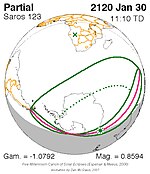 January 30, 2120 |
| 60 | 61 | 62 |
 February 9, 2138 | 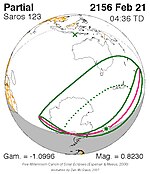 February 21, 2156 |  March 3, 2174 |
| 63 | ||
 March 13, 2192 | ||
Metonic series
The metonic series repeats eclipses every 19 years (6939.69 days), lasting about 5 cycles. Eclipses occur in nearly the same calendar date. In addition, the octon subseries repeats 1/5 of that or every 3.8 years (1387.94 days). All eclipses in this table occur at the Moon's ascending node.
| 23 eclipse events between August 3, 2054 and October 16, 2145 | ||||
|---|---|---|---|---|
| August 3–4 | May 22–24 | March 10–11 | December 27–29 | October 14–16 |
| 117 | 119 | 121 | 123 | 125 |
 August 3, 2054 |  May 22, 2058 |  March 11, 2062 |  December 27, 2065 |  October 15, 2069 |
| 127 | 129 | 131 | 133 | 135 |
 August 3, 2073 |  May 22, 2077 |  March 10, 2081 |  December 27, 2084 |  October 14, 2088 |
| 137 | 139 | 141 | 143 | 145 |
 August 3, 2092 |  May 22, 2096 |  March 10, 2100 |  December 29, 2103 | 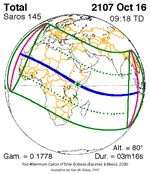 October 16, 2107 |
| 147 | 149 | 151 | 153 | 155 |
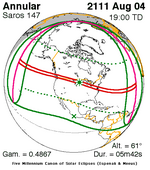 August 4, 2111 | 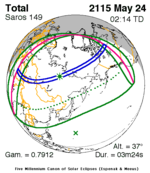 May 24, 2115 |  March 11, 2119 | 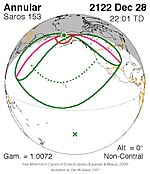 December 28, 2122 | 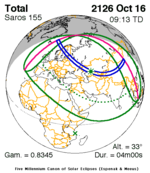 October 16, 2126 |
| 157 | 159 | 161 | 163 | 165 |
 August 4, 2130 |  May 23, 2134 |  October 16, 2145 | ||
Tritos series
This eclipse is a part of a tritos cycle, repeating at alternating nodes every 135 synodic months (≈ 3986.63 days, or 11 years minus 1 month). Their appearance and longitude are irregular due to a lack of synchronization with the anomalistic month (period of perigee), but groupings of 3 tritos cycles (≈ 33 years minus 3 months) come close (≈ 434.044 anomalistic months), so eclipses are similar in these groupings.
The partial solar eclipses on April 8, 1902 (part of Saros 108) and January 5, 1935 (part of Saros 111) are also a part of this series but are not included in the table below.
| Series members between 2000 and 2200 | ||||
|---|---|---|---|---|
 July 1, 2000 (Saros 117) |  June 1, 2011 (Saros 118) |  April 30, 2022 (Saros 119) |  March 30, 2033 (Saros 120) |  February 28, 2044 (Saros 121) |
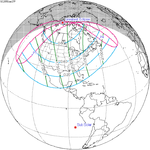 January 27, 2055 (Saros 122) |  December 27, 2065 (Saros 123) | 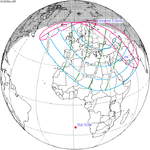 November 26, 2076 (Saros 124) | 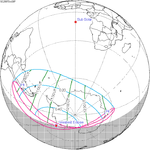 October 26, 2087 (Saros 125) |  September 25, 2098 (Saros 126) |
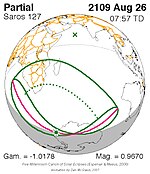 August 26, 2109 (Saros 127) | 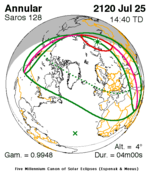 July 25, 2120 (Saros 128) |  June 25, 2131 (Saros 129) |  May 25, 2142 (Saros 130) |  April 23, 2153 (Saros 131) |
 March 23, 2164 (Saros 132) | 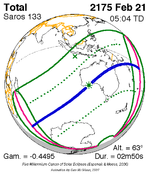 February 21, 2175 (Saros 133) |  January 20, 2186 (Saros 134) |  December 19, 2196 (Saros 135) | |
Inex series
This eclipse is a part of the long period inex cycle, repeating at alternating nodes, every 358 synodic months (≈ 10,571.95 days, or 29 years minus 20 days). Their appearance and longitude are irregular due to a lack of synchronization with the anomalistic month (period of perigee). However, groupings of 3 inex cycles (≈ 87 years minus 2 months) comes close (≈ 1,151.02 anomalistic months), so eclipses are similar in these groupings.
| Series members between 1801 and 2200 | ||
|---|---|---|
 June 26, 1805 (Saros 114) |  June 7, 1834 (Saros 115) |  May 17, 1863 (Saros 116) |
 April 26, 1892 (Saros 117) |  April 8, 1921 (Saros 118) |  March 18, 1950 (Saros 119) |
 February 26, 1979 (Saros 120) |  February 7, 2008 (Saros 121) |  January 16, 2037 (Saros 122) |
 December 27, 2065 (Saros 123) |  December 7, 2094 (Saros 124) |  November 18, 2123 (Saros 125) |
 October 28, 2152 (Saros 126) |  October 8, 2181 (Saros 127) | |
References
External links
- Earth visibility chart and eclipse statistics Eclipse Predictions by Fred Espenak, NASA/GSFC
- Besselian elements
- v
- t
- e
| By era | |
|---|---|
| Saros series (list) | |
| Visibility | |
| Historical |
|

Total/hybrid eclipses
→ next total/hybrid
- 1133
- 1185
- 1560
- 1598
- 1652
- 1654
- 1673
- 1706
- 1715
- 1724
- 1766
- 1778
- 1780
- 1806
- 1816
- 1824
- 1842
- 1851
- 1853
- 1857
- 1858
- 1860
- 1865
- 1867
- 1868
- 1869
- 1870
- 1871
- 1874
- 1875
- 1878
- 1882
- 1883
- 1885
- 1886
- 1887
- Jan. 1889
- Dec. 1889
- 1893
- 1896
- 1898
- 1900
- 1901
- 1903
- 1904
- 1905
- 1907
- Jan. 1908
- Dec. 1908
- 1909
- 1910
- 1911
- Apr. 1912
- Oct. 1912
- 1914
- 1916
- 1918
- 1919
- 1921
- 1922
- 1923
- 1925
- 1926
- 1927
- 1928
- 1929
- Apr. 1930
- Oct. 1930
- 1932
- 1934
- 1936
- 1937
- 1938
- 1939
- 1940
- 1941
- 1943
- Jan. 1944
- 1945
- 1947
- 1948
- 1950
- 1952
- 1954
- 1955
- 1956
- 1957
- 1958
- 1959
- 1961
- 1962
- 1963
- 1965
- 1966
- 1967
- 1968
- 1970
- 1972
- 1973
- 1974
- 1976
- 1977
- 1979
- 1980
- 1981
- 1983
- 1984
- 1985
- 1986
- 1987
- 1988
- 1990
- 1991
- 1992
- 1994
- 1995
- 1997
- 1998
- 1999
- 2001
- 2002
- 2003
- 2005
- 2006
- 2008
- 2009
- 2010
- 2012
- 2013
- 2015
- 2016
- 2017
- 2019
- 2020
- 2021
- 2023
- 2024
- → 2026
- 2027
- 2028
- 2030
- 2031
- 2033
- 2034
- 2035
- 2037
- 2038
- 2039
- 2041
- 2042
- 2043
- 2044
- 2045
- 2046
- 2048
- 2049
- 2050
- 2052
- 2053
- 2055
- Jan. 2057
- Dec. 2057
- 2059
- 2060
- 2061
- 2063
- 2064
- 2066
- 2067
- 2068
- 2070
- 2071
- 2072
- 2073
- 2075
- 2076
- 2077
- 2078
- 2079
- 2081
- 2082
- 2084
- 2086
- 2088
- 2089
- 2090
- 2091
- 2093
- 2094
- 2095
- 2096
- 2097
- 2099
- 2100
- 2186

Annular eclipses
→ next annular
- 1820
- 1854
- 1879
- 1889
- 1900
- 1901
- 1903
- 1904
- 1905
- 1907
- 1908
- 1911
- 1914
- Feb. 1915
- Aug. 1915
- 1916
- 1917
- 1918
- 1919
- 1921
- 1922
- 1923
- 1925
- 1926
- 1927
- 1929
- 1932
- Feb. 1933
- Aug. 1933
- 1934
- 1935
- 1936
- 1937
- 1939
- 1940
- 1941
- 1943
- Jul. 1944
- 1945
- 1947
- 1948
- 1950
- Mar. 1951
- Sep. 1951
- 1952
- Jan. 1954
- Dec. 1954
- 1955
- 1957
- 1958
- 1959
- 1961
- 1962
- 1963
- 1965
- 1966
- Mar. 1969
- Sep. 1969
- 1970
- 1972
- Jan. 1973
- Dec. 1973
- 1976
- 1977
- 1979
- 1980
- 1981
- 1983
- 1984
- 1987
- 1988
- 1990
- 1991
- 1992
- 1994
- 1995
- 1998
- 1999
- 2001
- 2002
- 2003
- 2005
- 2006
- 2008
- 2009
- 2010
- 2012
- 2013
- 2014
- 2016
- 2017
- 2019
- 2020
- 2021
- 2023
- → 2024
- 2026
- 2027
- 2028
- 2030
- 2031
- 2032
- 2034
- 2035
- 2036
- Jan. 2038
- Jul. 2038
- 2039
- 2041
- 2042
- 2043
- 2044
- 2045
- 2046
- 2048
- 2049
- 2052
- 2053
- Jan. 2056
- Jul. 2056
- 2057
- 2059
- 2060
- 2061
- 2063
- 2064
- 2066
- 2067
- 2070
- 2071
- Jan. 2074
- Jul. 2074
- 2075
- 2077
- 2078
- 2079
- 2081
- 2082
- 2084
- Jun. 2085
- Dec. 2085
- 2088
- 2089
- Feb. 2092
- Aug. 2092
- 2093
- 2095
- 2096
- 2097
- 2099
- 2100

Partial eclipses
→ next partial
- Jan. 1639
- Apr. 1902
- May 1902
- Oct. 1902
- Feb. 1906
- Jul. 1906
- Aug. 1906
- Dec. 1909
- Nov. 1910
- Apr. 1913
- Aug. 1913
- Sep. 1913
- Dec. 1916
- Jan. 1917
- Jun. 1917
- Jul. 1917
- May 1920
- Nov. 1920
- Mar. 1924
- Jul. 1924
- Aug. 1924
- Dec. 1927
- Jun. 1928
- Nov. 1928
- Apr. 1931
- Sep. 1931
- Oct. 1931
- Jan. 1935
- Feb. 1935
- Jun. 1935
- Jul. 1935
- Nov. 1938
- Mar. 1942
- Aug. 1942
- Sep. 1942
- Jan. 1946
- May 1946
- Jun. 1946
- Nov. 1946
- Apr. 1949
- Oct. 1949
- Feb. 1953
- Jul. 1953
- Aug. 1953
- Dec. 1956
- Mar. 1960
- Sep. 1960
- Jan. 1964
- Jun. 1964
- Jul. 1964
- Dec. 1964
- May 1967
- Mar. 1968
- Feb. 1971
- Jul. 1971
- Aug. 1971
- Dec. 1974
- May 1975
- Nov. 1975
- Apr. 1978
- Oct. 1978
- Jan. 1982
- Jun. 1982
- Jul. 1982
- Dec. 1982
- May 1985
- Apr. 1986
- Mar. 1989
- Aug. 1989
- Dec. 1992
- May 1993
- Nov. 1993
- Apr. 1996
- Oct. 1996
- Sep. 1997
- Feb. 2000
- 1 Jul. 2000
- 31 Jul. 2000
- Dec. 2000
- Apr. 2004
- Oct. 2004
- Mar. 2007
- Sep. 2007
- Jan. 2011
- Jun. 2011
- Jul. 2011
- Nov. 2011
- Oct. 2014
- Sep. 2015
- Feb. 2018
- Jul. 2018
- Aug. 2018
- Jan. 2019
- Apr. 2022
- Oct. 2022
- → Mar. 2025
- Sep. 2025
- Jan. 2029
- Jun. 2029
- Jul. 2029
- Dec. 2029
- 2032
- 2033
- Feb. 2036
- Jul. 2036
- Aug. 2036
- 2037
- May 2040
- Nov. 2040
- Jan. 2047
- Jun. 2047
- Jul. 2047
- Dec. 2047
- 2050
- Apr. 2051
- Oct. 2051
- Mar. 2054
- Aug. 2054
- Sep. 2054
- 2055
- May 2058
- Jun. 2058
- Nov. 2058
- Mar. 2062
- Sep. 2062
- Feb. 2065
- Jul. 2065
- Aug. 2065
- Dec. 2065
- 2068
- Apr. 2069
- May 2069
- Oct. 2069
- 2072
- 2073
- Jun. 2076
- Jul. 2076
- Nov. 2076
- Feb. 2083
- Jul. 2083
- Aug. 2083
- 2084
- 2086
- May 2087
- Jun. 2087
- Oct. 2087
- 2090
- 2091
- Jun. 2094
- Jul. 2094
- Dec. 2094
- Apr. 2098
- Sep. 2098
- Oct. 2098
 Astronomy portal
Astronomy portal Solar System portal
Solar System portal Category
Category
 | This solar eclipse–related article is a stub. You can help Wikipedia by expanding it. |
- v
- t
- e











